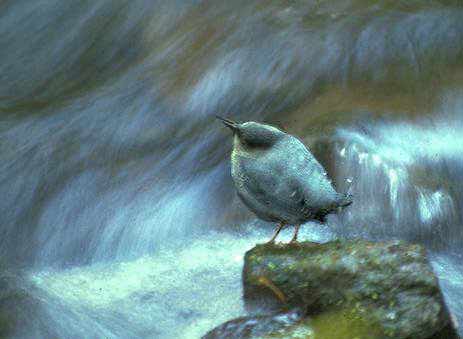From River of Traps, pages 219-221, by William deBuys,
reproduced here with his permission…

|
|
Image
by William Sullivan
|
There is a bird that lives along the Rio Trampas known as the dipper. Smaller than a robin, it behaves like a fish, for it never leaves the ribbon of stream in which it lives. Even in the depths of winter when the river is bridged with ice, it spends much of its time not just in the water, but under it. The dipper subsists, the year around, on the larvae of aquatic insects – caddis flies, mayflies, and the like. Perhaps because of its diet, the dipper has the brain of a trout. Although it flies with speed and agility, it uses its aerial skill in two directions only: upstream and downstream. When the river bends languidly around some point of land, the dipper will not fly the shortcut; without exception, it follows the bend… The dipper skims along, skinny wingtips beating fast and shallowly, like a fish’s tail...
It will have lighted on a boulder streaked white from previous visits. There the dipper studies the river and soon commences, with no sense of dignity or grace, to squat deeply and then stand up, squat and stand, and squat and stand again. These “dipping” exercises, which gave the bird its name, continue until the dipper steps into the stream to stroll underwater, pecking at larvae. Moments later the bird resurfaces a yard or two away, and bobs through the rapid like a fat cork, soon to scramble out on another white-strained rock to squat and stand again.
Although eccentric, the dipper possesses a number of admirable qualities, at least from an anthropocentric point of view. It is fervently loyal to its two-or-three-hundred-yard stretch of territory, seldom migrating more than a mile downstream in winter and sometimes not migrating at all. It also tends to be loyal to its mate, with whom it builds a nest well hidden beneath an overhang in the riverbank…
I admired the dipper for its tenacity and delighted in encouraging it on walks by the river, but my ideas about it slowly changed. Eventually the bird came to symbolize for me a persistent danger. Imagine a map of the dipper’s world. It would show a realm 50 feet wide by a thousand long, studded by intimately known rocks and eddies and fallen trees. To either side of the skinny homeland lies an infinite
terra incognita, a wilderness unacknowledged and unexplored. I worried, and so did Anne, that the village was becoming for us like the dipper’s patch of stream, that we were beginning to mistake the familiar horizons of the valley for those of the world.
Return to main part of deBuys Q&A

